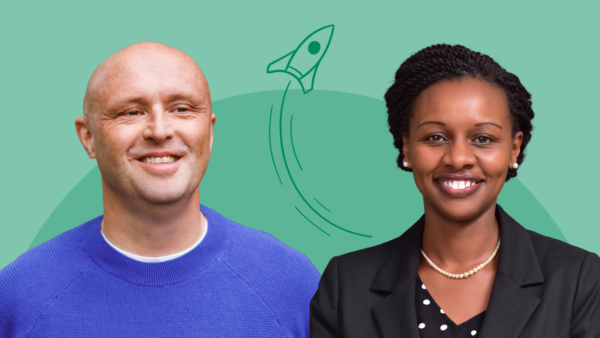Podcast transcript:
Is there more change at work than ever before?
Change at work can be a deeply unsettling time. Perhaps you’re coming to the end of a major project and you’re unsure what’s coming along next. Perhaps there has been turbulence in your organisation’s world – increased competition, changes in legislation, economic headwinds, or whatever – and that means that your team is more focused on surviving than thriving right now. Maybe your organisation is rationalising, so teams are starting to be merged and combined, threatening the team dynamic that you’ve been comfortable with for months or years.
Might change need a reframe – as an opportunity, not a threat?
Change can take so many forms. And for most of us, it is registered in the brain as a threat rather than an opportunity. But if change is now so commonplace, and it’s stability that’s become unusual, maybe we can consider reframing change so that we’re less likely to deny or resist it and more likely to look for learning and opportunity for growth for ourselves. Today, we’re talking about the strengths approach to learning through change.
The grieving cycle or the DREC curve… a very human response to change
We know that most people, when faced with change, will go through a pattern of emotions and responses. This can be seen as a process of transition, of letting go and looking towards the future, while grieving for what’s been lost. The DREC model (based on the work of Elizabeth Kubler-Ross) describes this well for me, in that it’s relatable and practical and also, hopeful, without being overly optimistic. DREC stands for Denial, Resistance, Exploration, Commitment.
It’s seen to follow a curve down (in terms of our levels of engagement, mood and performance) as we transition from denying that a change is coming to resisting the change and trying to maintain the status quo. This takes us to the deepest part of the trough of the curve, where we reach a point in time of considering what the future might hold (exploration) while still craving the comfort of the past (even though it’s no longer an option for us). From this point on (bearing in mind actually that the emotional process of transitioning through change isn’t linear), we tend to focus an increased amount of our time on the future, moving through exploration and then, once we better understand the changes that are required and we believe in their value, we commit to them and they become our new way of thinking or behaving.
Making choices about transitioning through change
By introducing strengths to the process of change, we can better equip ourselves to manage the various transitions that come with it and to take opportunities for learning and growth along the way. Here’s my guide to the strengths approach to learning through change in the form of 4 top tips.
- Bounce forward not back – ask yourself what can you learn during change?
‘Resilience’ is a word that’s often associated with coping with change and is most often defined as effectively ‘bouncing back’ from a challenge or trauma. But what if rather than bouncing back, we instead aimed to bounce forward from challenge and change…resolving to come out of the other side stronger, more knowledgeable and more ready to deal with the next wave of change following behind?
Periods of change can sometimes give us the opportunity and the requirement to upskill so that we are able to meet the challenges of any new ways of working or new opportunities head on. In other contexts of change, there may be a pause in project work where a choice emerges as to whether we use the relative downtime in this lull to upskill and upknowledge ready for the next project or next career opportunity, or alternatively, where we take a more passive approach, waiting for something to happen.
Taking a more proactive approach and seeing change as an opportunity not a threat means that you can focus on building your CV, your transferable skills, as well as the meeting the skill and behavioural needs of the new context.
So tip 1 is to stay alert to upcoming change and when you get the confirmation that you’ll need to alter your approach rather than holding on to established ways of doing things, instead try and get ahead and transition more quickly through the change stages of denial and resistance by looking for the opportunity that there may be for you to gain new skills and new knowledge which may benefit you long after you’ve left your current role or organisation.
- Get some psychological safety so that you’re open to learn
Secondly, as a precursor to learning, you need to feel safe. Partly, reframing change as an opportunity can help you create the conditions for psychological safety for yourself (because you are taking your future into your own hands by using it as an opportunity to upskill).
However, it’s also important to feel that your team has your back and that adopting a growth mindset doesn’t carry too much risk. Growth mindset, which I cover in detail at Season 9, episode 11 – what is growth mindset and how can you develop one, requires you to take risks as part of your learning journey. So it needs to be ok to make mistakes, to learn from them and to go again.
If this isn’t part of your team’s make up right now, I would strongly recommend that it becomes part of the team’s accepted ways working. Make learning an expectation in your team (part of your team’s purpose and values). Get it social, get it discussed and get people’s worries and anxieties on the table, rather than people holding back.
Tip 2 then is to make sure you’re safe before you start learning. Learning and upskilling requires you to take risks and to be vulnerable. Without safety, that’s far less likely to happen.
- Focus on your strengths to power up your learning, whatever the skills journey
Once you have the right conditions for learning in place, it’s a good time to bring strengths into play. First thing to say is that your strengths bring certainty. They are anchors for you even when your context is shifting and the future is uncertain.
When you know your strengths, you can start using them as tools to support your learning. You have a Relationship building strength? Then connect with other people who’ve been on a similar change journey to you and ask for their advice. You have an Efficiency strength? Best to make a learning plan so that you’ll feel motivated to those areas where you need to upskill. Have an Enthusiasm strength? Then make sure that you’re communicating your new knowledge to others, or sharing with them the resources you found that helped you…that way, you can stay energised throughout the change journey.
Whatever strengths you have, when you give it some thought, you’ll be able to use those strengths to develop your own learning plan and your learning journey. And that’s before you’ve considered the strengths that also exist across your team. In areas where you feel drained, as long as you feel safe enough to ask, it is more than possible to tap into the strengths of your colleagues to get your learning underway. Maybe asking those with a Self-improvement strength for example for their tips on upskilling. Or those with a Common sense strength which learning resources have the best evidence supporting them.
Tip number 3 is to get your strengths, and the strengths of others, working for you. And consider how you may be able to bring your strengths into service for your colleagues too. Remember that everyone’s strengths are unique and this can bring a big benefit when you need to go through a process of change and learning.
- Focus on building out your strengths for a supercharged learning experience
My final tip involves taking your learning and upskilling plan to the next level during change by directing your learning towards your strengths themselves.
We know that strengths are those qualities that bring us energy and that we are great at or have the potential to become great at. So what better approach to learning and upskilling than to select a strength or strengths that you are strong in delivering already and consider how you can take them to the next level.
While you’re in a transitional period, is now the time to take your Detail orientation, Results focus and Efficiency strengths and seek out a project management training programme to get even more from them? What about developing your Empathy and Collaboration strengths by coaching or mentoring others? Or using your Persuasiveness and Enthusiasm strengths to learn how to communicate with impact even more effectively. Again, spending time considering how you can bring your strengths into your learning – in this case, making them the focus of your learning plan – should bring energy and focus to your learning and development activity.
If you’d like more on how to go about doing this, check out my podcast at Season 12, episode 10 – What is strengths-based learning and development and why does it matter?
In conclusion, see change as an opportunity to STOP before proceeding
Change at work gives cause to STOP. Which I’m using as an acronym for step back, think, organise and then proceed. When we do this mindfully, we can access powerful learning to help us in our careers and in our current roles for when we’re through the change and facing into our new normal. So why not start seeing change as an opportunity to learn. To bounce forward, rather than back. To explore rather than to resist. And to CV build while taking a macro look at our careers. Till next time, stay strong.













